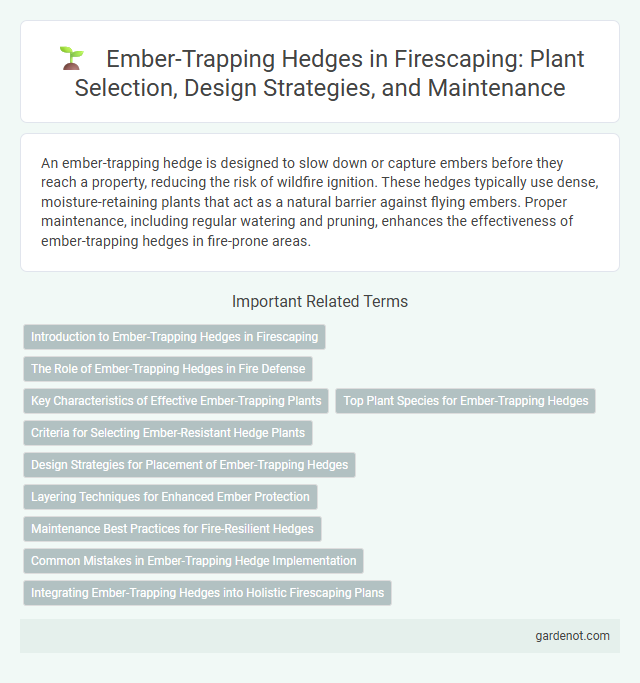An ember-trapping hedge is designed to slow down or capture embers before they reach a property, reducing the risk of wildfire ignition. These hedges typically use dense, moisture-retaining plants that act as a natural barrier against flying embers. Proper maintenance, including regular watering and pruning, enhances the effectiveness of ember-trapping hedges in fire-prone areas.
Introduction to Ember-Trapping Hedges in Firescaping
Ember-trapping hedges play a crucial role in firescaping by capturing and reducing flying embers that can ignite property during wildfires. These hedges are typically composed of dense, low-flammability plant species designed to disrupt ember flow and prevent fire spread. Incorporating ember-trapping hedges strategically around homes enhances fire defensible space and contributes significantly to wildfire resilience.
The Role of Ember-Trapping Hedges in Fire Defense
Ember-trapping hedges act as crucial barriers in wildland fire defense by capturing and reducing the spread of burning embers before they reach structures or vulnerable vegetation. These dense, fire-resistant shrubs and plants create a physical shield that intercepts embers carried by wind, significantly lowering the risk of ember ignition around homes and landscapes. Incorporating ember-trapping hedges into a firescape design enhances property protection by minimizing ember-driven fire spread and increasing overall fire resilience.
Key Characteristics of Effective Ember-Trapping Plants
Effective ember-trapping plants feature dense, coarse foliage that can intercept flying embers and reduce fire spread near structures. Species with thick, waxy leaves and high moisture content enhance fire resistance by slowing ignition and combustion. Strategic placement of these shrubs or hedges creates a natural barrier, minimizing ember intrusion and protecting vulnerable areas during wildfires.
Top Plant Species for Ember-Trapping Hedges
Top plant species for ember-trapping hedges include densely branched evergreens such as California lilac (Ceanothus), boxwood (Buxus sempervirens), and Oregon grape (Mahonia aquifolium), which create effective barriers against ember intrusion. These species possess thick, moisture-retentive foliage and fire-resistant characteristics that reduce the likelihood of ignition during wildfires. Incorporating native, low-flammability plants like sumac (Rhus integrifolia) and toyon (Heteromeles arbutifolia) enhances the hedge's ember-trapping capacity while supporting local ecosystem resilience.
Criteria for Selecting Ember-Resistant Hedge Plants
Selecting ember-resistant hedge plants requires prioritizing species with thick, moisture-rich foliage and minimal dead material to reduce flammability. Plants with low resin or oil content, such as holly or boxwood, effectively trap embers without igniting. Proper spacing and maintenance, including regular pruning and removal of dead debris, enhance the hedge's capacity to act as a fire barrier.
Design Strategies for Placement of Ember-Trapping Hedges
Ember-trapping hedges should be strategically placed near vulnerable structures and along property boundaries to intercept airborne embers before they reach buildings. Selecting dense, fire-resistant plant species with moist foliage enhances ember-trapping effectiveness while minimizing fuel loads. Positioning these hedges at windward edges where ember exposure is highest maximizes protection by reducing ember intrusion into defensible spaces.
Layering Techniques for Enhanced Ember Protection
Ember-trapping hedges utilize layering techniques by combining dense, fire-resistant shrubs with strategically spaced branches that disrupt ember flow and reduce ignition risks. Integrating varied plant heights and textures creates multiple barriers, effectively capturing embers before they can reach vulnerable structures. This multi-layered design improves overall fire resilience and enhances protection against ember storms near properties.
Maintenance Best Practices for Fire-Resilient Hedges
Regular pruning of ember-trapping hedges is essential to maintain fire-resilience by removing dead branches and reducing dense foliage that can ignite easily. Irrigating these hedges adequately prevents drought stress, which increases flammability during wildfire events. Applying mulch away from the base minimizes ember accumulation, ensuring maintenance aligns with fire-safe landscaping principles.
Common Mistakes in Ember-Trapping Hedge Implementation
Common mistakes in ember-trapping hedge implementation include selecting dense or resinous plants that increase fire fuel load and positioning hedges too close to structures, which facilitates ember intrusion. Improper pruning leading to overgrown foliage creates continuous fuel beds that amplify ember accumulation. Neglecting to maintain clear gaps between plants and using flammable mulch beneath hedges also significantly elevates the risk of ember-based ignition.
Integrating Ember-Trapping Hedges into Holistic Firescaping Plans
Ember-trapping hedges strategically integrated into firescaping plans serve as crucial barriers against wind-driven embers, significantly reducing wildfire risk near properties. Selecting dense, low-flammability plants with high moisture content enhances the hedge's effectiveness in intercepting embers before they reach vulnerable structures. Incorporating these hedges within defensible space zones complements other fire-resistant landscaping techniques, optimizing overall wildfire resilience.
Ember-trapping hedge Infographic

 gardenot.com
gardenot.com